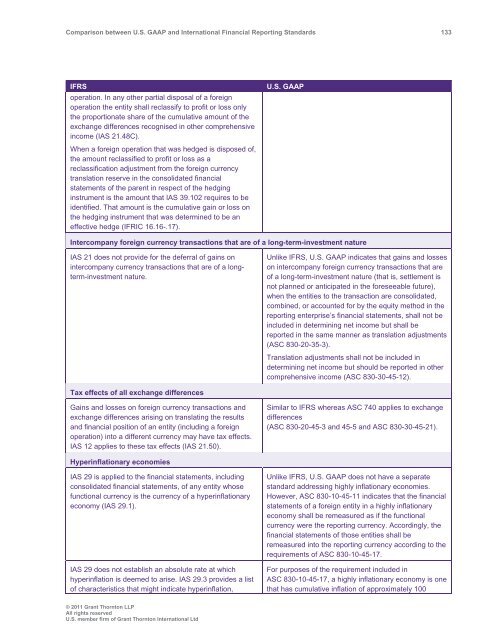Comparison between U.S. GAAP and International ... - Grant Thornton
Comparison between U.S. GAAP and International ... - Grant Thornton
Comparison between U.S. GAAP and International ... - Grant Thornton
Create successful ePaper yourself
Turn your PDF publications into a flip-book with our unique Google optimized e-Paper software.
<strong>Comparison</strong> <strong>between</strong> U.S. <strong>GAAP</strong> <strong>and</strong> <strong>International</strong> Financial Reporting St<strong>and</strong>ards 133<br />
IFRS<br />
operation. In any other partial disposal of a foreign<br />
operation the entity shall reclassify to profit or loss only<br />
the proportionate share of the cumulative amount of the<br />
exchange differences recognised in other comprehensive<br />
income (IAS 21.48C).<br />
When a foreign operation that was hedged is disposed of,<br />
the amount reclassified to profit or loss as a<br />
reclassification adjustment from the foreign currency<br />
translation reserve in the consolidated financial<br />
statements of the parent in respect of the hedging<br />
instrument is the amount that IAS 39.102 requires to be<br />
identified. That amount is the cumulative gain or loss on<br />
the hedging instrument that was determined to be an<br />
effective hedge (IFRIC 16.16-.17).<br />
U.S. <strong>GAAP</strong><br />
Intercompany foreign currency transactions that are of a long-term-investment nature<br />
IAS 21 does not provide for the deferral of gains on<br />
intercompany currency transactions that are of a longterm-investment<br />
nature.<br />
Unlike IFRS, U.S. <strong>GAAP</strong> indicates that gains <strong>and</strong> losses<br />
on intercompany foreign currency transactions that are<br />
of a long-term-investment nature (that is, settlement is<br />
not planned or anticipated in the foreseeable future),<br />
when the entities to the transaction are consolidated,<br />
combined, or accounted for by the equity method in the<br />
reporting enterprise’s financial statements, shall not be<br />
included in determining net income but shall be<br />
reported in the same manner as translation adjustments<br />
(ASC 830-20-35-3).<br />
Translation adjustments shall not be included in<br />
determining net income but should be reported in other<br />
comprehensive income (ASC 830-30-45-12).<br />
Tax effects of all exchange differences<br />
Gains <strong>and</strong> losses on foreign currency transactions <strong>and</strong><br />
exchange differences arising on translating the results<br />
<strong>and</strong> financial position of an entity (including a foreign<br />
operation) into a different currency may have tax effects.<br />
IAS 12 applies to these tax effects (IAS 21.50).<br />
Similar to IFRS whereas ASC 740 applies to exchange<br />
differences<br />
(ASC 830-20-45-3 <strong>and</strong> 45-5 <strong>and</strong> ASC 830-30-45-21).<br />
Hyperinflationary economies<br />
IAS 29 is applied to the financial statements, including<br />
consolidated financial statements, of any entity whose<br />
functional currency is the currency of a hyperinflationary<br />
economy (IAS 29.1).<br />
IAS 29 does not establish an absolute rate at which<br />
hyperinflation is deemed to arise. IAS 29.3 provides a list<br />
of characteristics that might indicate hyperinflation,<br />
Unlike IFRS, U.S. <strong>GAAP</strong> does not have a separate<br />
st<strong>and</strong>ard addressing highly inflationary economies.<br />
However, ASC 830-10-45-11 indicates that the financial<br />
statements of a foreign entity in a highly inflationary<br />
economy shall be remeasured as if the functional<br />
currency were the reporting currency. Accordingly, the<br />
financial statements of those entities shall be<br />
remeasured into the reporting currency according to the<br />
requirements of ASC 830-10-45-17.<br />
For purposes of the requirement included in<br />
ASC 830-10-45-17, a highly inflationary economy is one<br />
that has cumulative inflation of approximately 100<br />
© 2011 <strong>Grant</strong> <strong>Thornton</strong> LLP<br />
All rights reserved<br />
U.S. member firm of <strong>Grant</strong> <strong>Thornton</strong> <strong>International</strong> Ltd
















